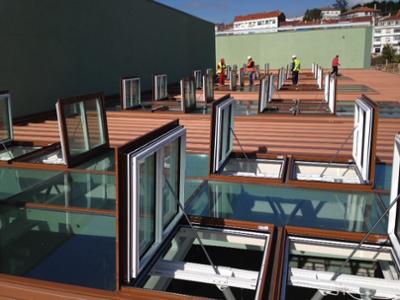

Smoke control is key to safe evacuation
Santos Bendicho, from the Smoke Control and Evacuation Committee of TECNIFUEGO, the Spanish Association of Fire Protection Companies, emphasises the need to make society aware of the importance of temperature and smoke control systems to guarantee a safe evacuation of the occupants of a building, as well as to improve the intervention conditions of the extinguishing services.
The smoke control sector continues to develop rapidly, mainly due to economic developments and also due to the continuous development of logistics facilities on the one hand, and real estate development in the commercial sector on the other hand. In the regulatory field, the inclusion for the first time of smoke control systems in the latest version of the RIPCI has made it possible to highlight the value of these systems in their different modes of use depending on the type of building and the smoke control strategy used, although there is still some way to go in terms of both the professionalisation of installations through the training required by the regulation and the maintenance of smoke control systems.
According to Santos Bendicho, "the main challenge we must face is the need to transmit and make society aware of the importance of temperature control and smoke evacuation systems to guarantee the safe evacuation of the occupants of a building, as well as to improve the intervention conditions of the extinguishing services". Smoke control systems play a major role in TECNIFUEGO's Zero Victims goal, since most of the victims of a fire are caused by the risks derived from smoke.
At the technological level, "we must impose self-demanding standards on the design, installation and maintenance of smoke control systems to ensure their perfect operation in the event of a fire". Furthermore, "we need to continue to make progress in ongoing research in order to have a better understanding of the smoke behaviour, especially in situations where it is affected by other installations or extreme environmental conditions, which may require specific installations or products".
Adapting to the needs
The future must be geared towards being able to adapt the design of smoke control systems to the specific needs of new construction standards at industrial level. For instance, with multi-storey logistics buildings, and to unique architectures with complex morphologies in public buildings, all without losing sight of the challenge of energy efficiency and sustainability that will inevitably mark the construction requirements of all buildings in the coming years. "This will require imagination, both in terms of system design and in the development of new products, especially those with high thermal insulation performance.
Bendicho states that "once the revision of the standard for the installation, commissioning and maintenance of smoke control systems, UNE 23584, has been published, and it has not been possible to do so prior to the submission of the RSCIEI for public information, the committee should focus its work on explaining to the market the improvements that the application of this new revision of 2023 entails in order to have a greater degree of safety in the installation of smoke control systems, as well as a greater requirement in the process of commissioning and testing of the installation, and subsequent maintenance".





